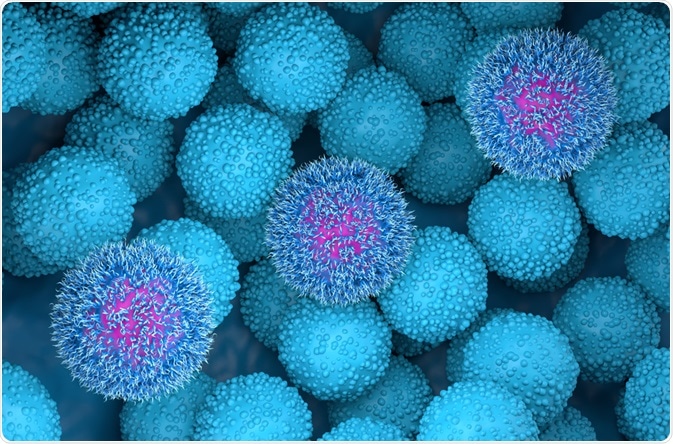In human tumor xenograft models, human tumor cells, collected by biopsy or cultured from a known cell line, are transplanted into immunocompromised mice that do not reject human cells, either under the skin (ectopic model) or into the organ type from which the tissue originated (orthotopic model). This allows researchers to assess the efficacy and safety of a drug or therapy towards a particular patient’s tumor in an in vivo setting.
 Image Credit: Nemes Laszlo/Shutterstock.com
Image Credit: Nemes Laszlo/Shutterstock.com
Following transplant, the tumor is usually allowed to develop for a period of weeks or months, and then the drug regimen or therapy under investigation can be applied. The efficacy of the treatment can be monitored by observing tumor volume compared to a control, while toxicity may be roughly monitored by overall body mass change and frequency of drug-related deaths.
Ectopic models are particularly convenient for these types of analysis, as the tumor is easily visible under the skin. Multiple tumor types can be simultaneously transplanted into different areas on a single mouse, allowing the efficacy of a treatment towards each to be compared.
Orthotopic models are significantly more costly and complex to arrange, requiring skilled surgery to implant the tumor into the target organ with good reproducibility across mice. Fluorescence imaging, magnetic resonance imaging, or computerized tomography can be used to monitor the progression of an internal tumor, but without access to this equipment, sacrifice is necessary.
Orthotopic models generally replicate in situ conditions for the tumor better, exhibiting faster early-stage growth, angiogenesis, and in some cases metastasis. Metastasis can also be replicated strategically, by firstly implanting a tumor and allowing it to spread, before removing it again. Alternatively, cancer cells can be injected intravenously to act like cancer stem cells. Metastasized cancers may respond differently to the primary tumor towards a therapy, at a range of doses, thus the production of metastases-bearing mice is of value in a drug development context.
Patient-derived xenografts are the ultimate simulation of a particular patient's tumor in an animal model. However, the immunocompromised mice (nude mice) frequently utilized in tumor xenograft models do not possess a fully working, and therefore entirely representative, immune system of healthy humans. Since the mice must be immunocompromised, so as to not reject the implanted human cells, the immune response towards the cancer itself is unrealistic. Several grades of immunocompromised mice have been developed in the preceding decades that replicate the human immune system to varying degrees.
Types of murine model
Nude mice are laboratory mice with a genetic mutation that leaves them without a thymus, greatly inhibiting their immune system. These mice still bear relatively intact B cells, dendritic cells, and granulocytes, and some studies have suggested that the immune system of these mice overcompensates for deficiencies by overproducing other immune cells such as natural killer cells and tumoricidal macrophages.
However, this system produces good results with regard to assessing the response of the tumor towards a drug regime while providing realistic tumor heterogeneity.
In cases where an accurate tumor microenvironment must be simulated more closely than possible by nude mice, humanized mice can be employed at somewhat greater expense. Humanized mice include severely compromised immunodeficient (SCID) mice that have a modified PRKDC gene to produce impaired T and B lymphocytes, and non-obese diabetic (NOD) mice that entirely lack T, B, and natural killer cells.
In vivo Patient-Derived Xenograft (PDX) Models for Oncology Research Studies
A large number of additional murine models with defective production of all interleukin types, knocked out recombination activation genes, and other intentional immunodeficiencies have been deployed or are in development around the world. The aim of these is to lessen the influence of the murine immune system against the human tumor xenograft while simulating the human immune system to differing extents in various aspects.
A number of methods of simulating the human immune system have been proposed, from the extraction of hematopoietic stem cells from the original patient’s bone marrow for the ultimate personalized medicine approach to infection of the mice with a battery of common human pathogens that induce the development of a similar environment. In any case, these methods are yet unable to capture the full complexity of the human immune response while eliminating any influence of the living organism into which the human tumor xenograft has been transplanted.
While mice remain the most popular animal utilized for tumor xenograft models thanks to the rate at which they multiply, and the extensive research and resulting genetic manipulation that has already been carried out on the species, other animal models have been developed. Dogs are genetically more similar to humans than mice, and primates are innately more similar still. Both animals have had human tumor xenografts applied in the past, though done with lessening frequency due to ethical considerations, and as the obvious advantages of humanized murine models become more pronounced.
Sources
- Richmond, A. & Su, Y. (2008) Mouse xenograft models vs GEM models for human cancer therapeutics. Disease models & mechanisms, 1(2-3). https://pubmed.ncbi.nlm.nih.gov/19048064/
- Jung, J. (2014) Human Tumor Xenograft Models for Preclinical Assessment of Anticancer Drug Development. Toxicological research, 30(1). https://www.ncbi.nlm.nih.gov/pmc/articles/PMC4007037/
- Gomez-Cuadrado, L. et al. (2017) Mouse models of metastasis: progress and prospects. Disease models & mechanisms, 10(9). https://www.ncbi.nlm.nih.gov/pmc/articles/PMC5611969/
- Pearson, T., Greiner, D. L. & Shultz, L. D. (2011) Creation of “Humanized” Mice to Study Human Immunity. Current protocols in immunology, 15(21). https://www.ncbi.nlm.nih.gov/pmc/articles/PMC3023233/
- Tao, L. & Reese, T. A. (2017) Making Mouse Models That Reflect Human Immune Responses. Trends in immunology, 38(3). https://www.cell.com/trends/immunology/fulltext/S1471-4906(17)30001-7
- Li, Z. et al. (2021) Application of Animal Models in Cancer Research: Recent Progress and Future Prospects. Cancer management and research, 13. www.dovepress.com/application-of-animal-models-in-cancer-research-recent-progress-and-fu-peer-reviewed-fulltext-article-CMA
Further Reading
Last Updated: Aug 21, 2023